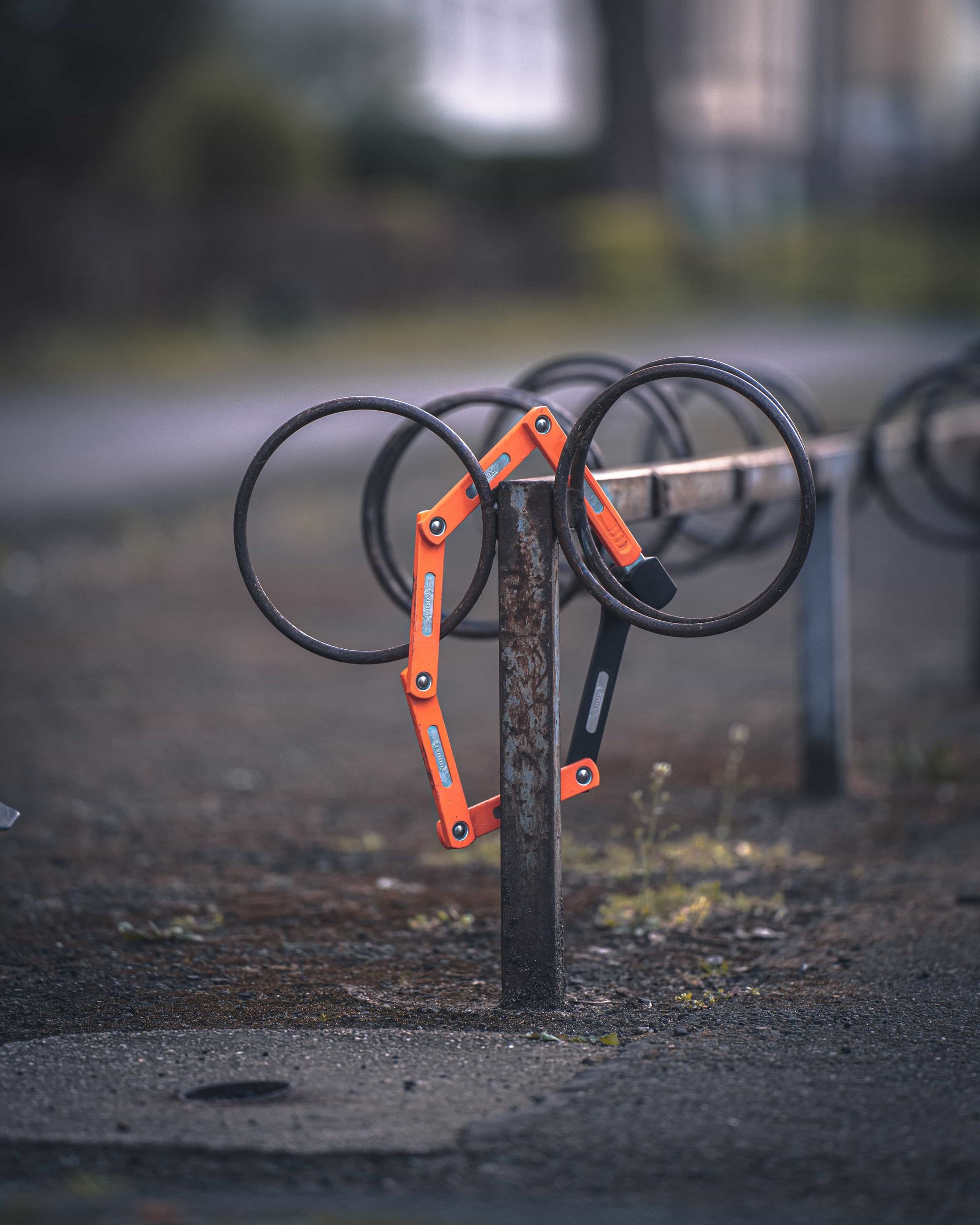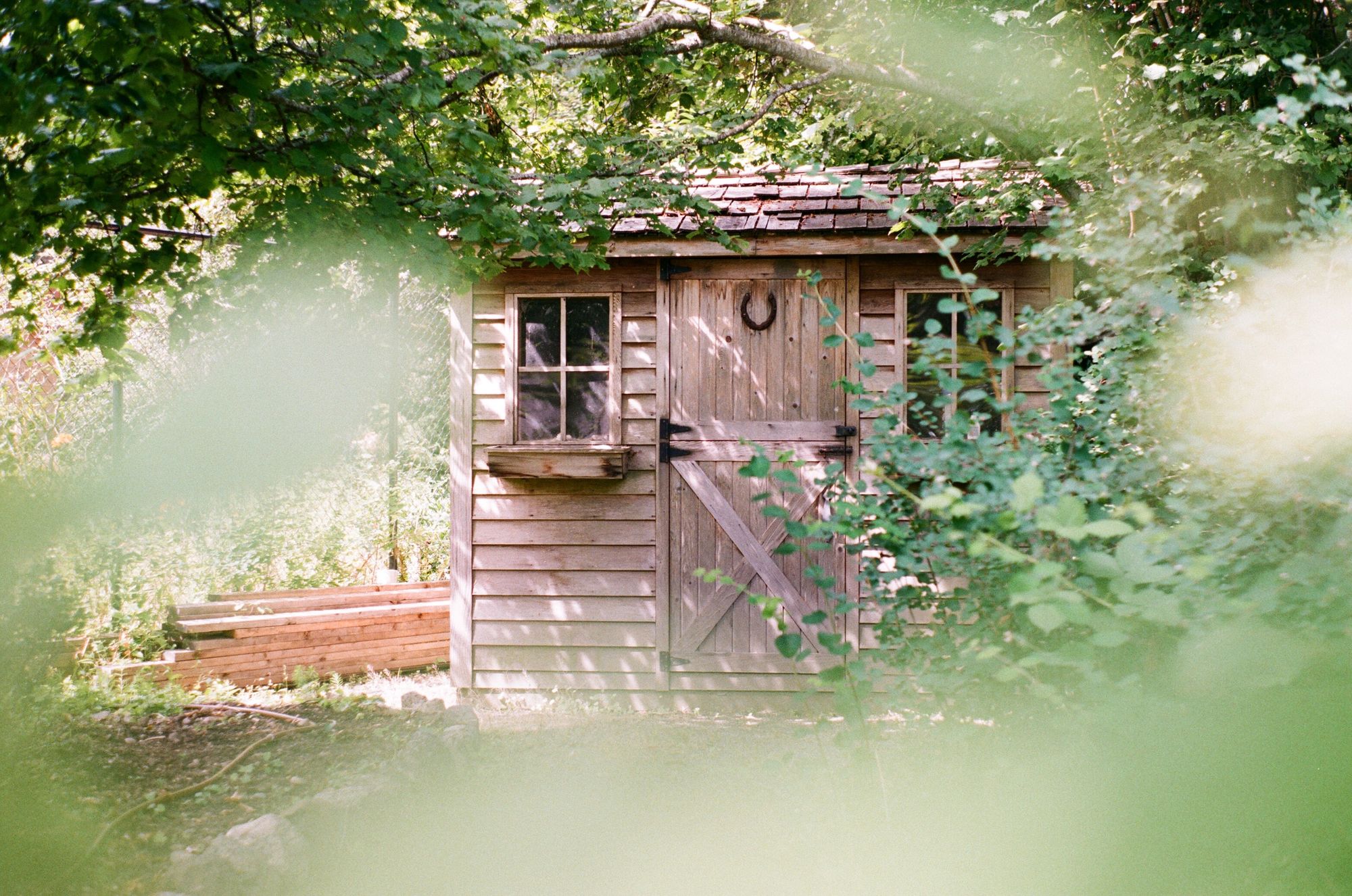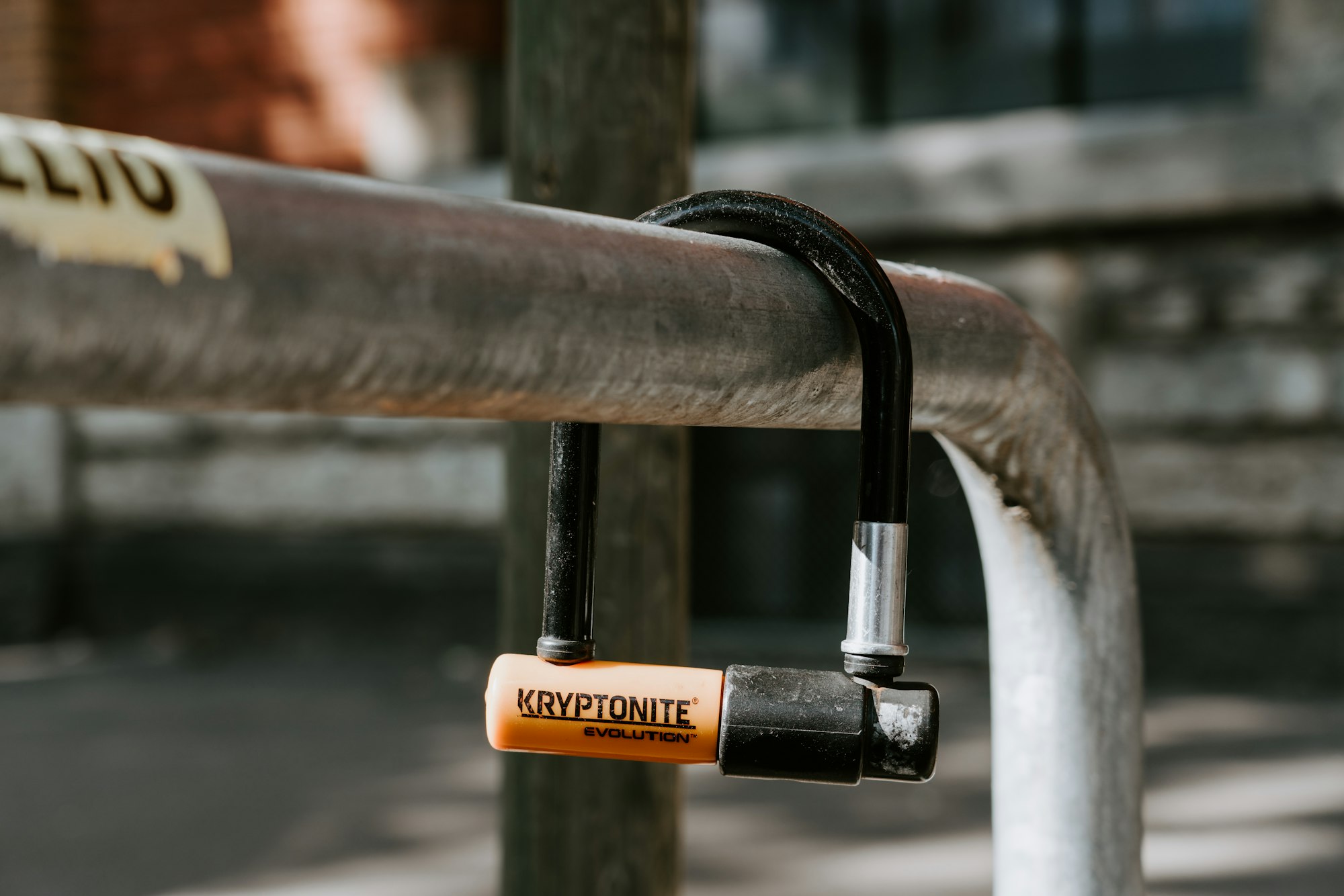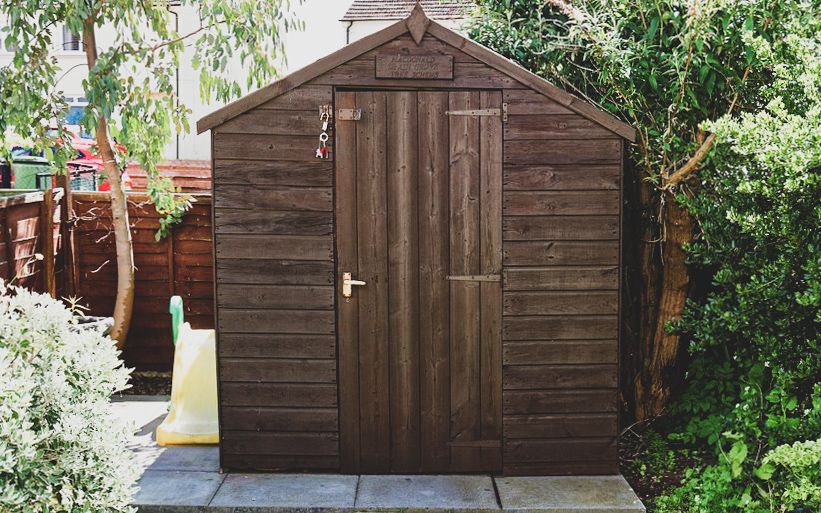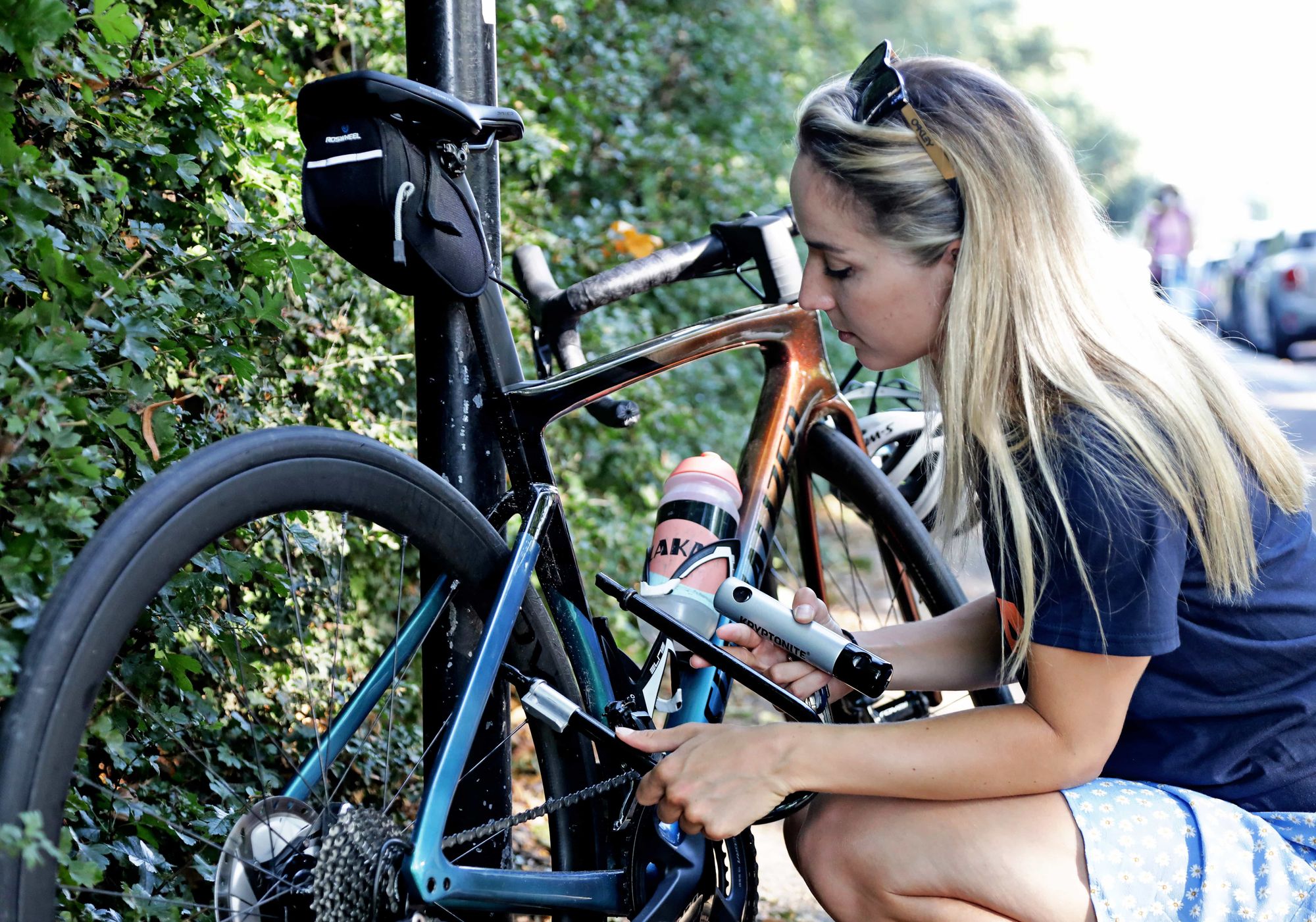The first line of defence for all bike lovers is an insurance-approved bike lock, but there are so many on the market how can you be sure you’re not wasting your money? The second is understanding how to lock your bike correctly.
What are the 5 most common types of bike locks?
We’re going to focus on 5 of the best bike locks: D lock, chain lock, wearable locks, folding locks, and cable locks.
1. D lock
D locks (also known as U locks) come in various sizes and Sold Secure ratings (more on those in a bit). They are heavy-duty, but the D lock shape only fits around thin racks, so they won’t go around a lamp post. That’s why many also have a chain attached so you can secure your wheel and the frame.
Because the cable’s easier to cut than the D lock, the safest way to stash your bike is to manoeuvre the ‘D’ so it locks your frame and wheel to the rack.
2. Chain lock
A chain lock is a large, heavy-duty steel chain with a locking mechanism (usually either key and padlock or D lock) to secure either end. The chain is usually covered in a protective sleeve made from nylon or Kevlar to prevent cutting. It also prevents the chain from scratching your bike.
The benefit of them is that they offer a large locking area and the strength of a D lock. However, their weakness is the locking mechanism. But if you opt for one of our Sold Secure gold bike locks, you’ll benefit from resistance to lock-picking and impact damage.
3. Wearable locks
As the name suggests, it’s a lock you can wear, which is therefore very portable, unlike the previous types mentioned. But that does mean you compromise on robustness. However, you can get both Sold Secure Gold and Diamond-rated wearable locks.
Now that you know about the different types of bike locks that are available, it’s time to explain the Sold Secure rating we’ve mentioned a few times.
4. Folding Locks
Folding locks consist of several metal bars linked by rivets, allowing them to fold into a compact shape. These locks are lightweight and easy to carry, making them a convenient choice for everyday use.
While they may not be as robust as D locks or chain locks, folding locks offer a good balance of security and portability, with many receiving high Sold Secure ratings.
5. Cable Locks
Cable locks are flexible and easy to use, making them a popular choice for securing bikes in low-risk areas. These locks are made of intertwined steel cables and are usually covered in a plastic coating to prevent scratching.
While they are not as secure as D locks or chain locks, cable locks are ideal for quick stops or as a secondary lock to provide extra security for your bike. Choose a cable lock with a high Sold Secure rating for added peace of mind. Now that you know about the different bicycle locks that are available, it’s time to explain the Sold Secure rating we’ve mentioned a few times.
What is a Sold Secure rating?
How can you be sure that the bike lock you buy is suitable and approved by bike insurance providers?
That’s where the Sold Secure rating comes in. It is a rating system awarded on locks that the Master Locksmiths Association has independently tested. There are four levels of security, which are categorised as follows:
| Protection | How long it will withstand attack | Use | |
|---|---|---|---|
| Bronze | Medium Security | 1 Minute | Café stops/quick stops. May put off opportunist thieves. |
| Silver | High Security | 3 Minutes | May put off opportunist thieves and gives some protection from a determined thief. |
| Gold | Maximum Security | 5 Minutes | Ideal if your bike is locked up in public areas for a significant period. Offers good protection from potential theft. |
| Diamond | Ultimate Security | 5+ Minutes | Highest level of security and resistance to theft. Perfect for high-value bikes left in public spaces. |
If you're serious about keeping your precious ride safe, it’s vital to choose locks with higher security ratings. Avoid using Sold Secure silver or bronze locks, as they may not offer the level of protection needed for high-risk areas.
In a moment, we’ll share with you some examples of Gold and Diamond rated bike locks, but if you already have your eye on one, or need to see your options, check out the Sold Secure website. It has a handy search tool. Just enter the level of protection and the type of lock you want, and it will show you what’s available.
Which bike locks are insurance-approved?
It pays to go for the highest protection possible, which is why many bike insurers stipulate your lock must be either Sold Secure Gold or Diamond rated. So, they are the ones we’re going to be looking at.
You can find these protection levels in all the bike lock types we mentioned earlier. To help you narrow your search, we’ve listed some possible contenders below.
Gold-rated bike locks
- Kryptonite Evolution (standard) - D Lock - £59.99
- OnGuard Pitbull - D Lock - £28.99
- OnGuard Mastiff 8019 - Chain Lock - £46.99
- Hiplok Gold - Wearable Lock - £79.99
- Litelock Core Flex - Wearable Lock - £119.99
In the market for a new gold-rated lock? Check out our complete list of deals from across the web.
Diamond-rated bike lock
- Kryptonite New York Fahgettaboudit Mini - D Lock - £109.99
- Hiplok DX - D Lock - £79.99
- Kryptonite New York Fahgettaboudit - Chain Lock - £149.99
- Litelock Core Plus - Wearable Lock - £139.99
How to lock your bike securely
Now that you’ve found the perfect bike lock, it’s time to review a few simple ways to ensure you know how to lock a bike securely. This might sound like we’re teaching you to suck eggs, but there’s no point investing in a decent bike and lock if you don’t find somewhere secure to leave it.
1. Find a solid, immovable object
First, find a solid, immovable object to lock your bike to – a bike rack, lamp post or railing (but only if it's legal).
2. Secure through the frame, not just the wheel
Next, think about how you’re going to lock it. If you lock it up through your wheel, don’t be surprised if it’s not there when you get back. Most bikes have quick-release wheels, so it won’t take long for a would-be thief to run off with your pride and joy.
3. Position the lock to deter thieves
To deter even the most determined bike thief, lock your bike through the frame and have the lock in a position that makes it impossible to use leverage or force against another surface.
4. Choose a public area with high footfall
Finally, think about where you’re leaving your bike. If you opt for a side street or alleyway, you’re providing a thief with a relatively secluded area in which to carry out their dastardly deed undetected.
A better option is in a public area with high footfall. That will deter thieves because they will probably be spotted, and there’s a fair chance there will be a CCTV camera nearby.
For storing your bike at home, consider getting a secure bike shed.
Don’t forget your bicycle insurance
We hope you’ve found this guide on insurance-approved bike locks useful. Always remember:
- Buying a decent lock is your first line of defence against bike thieves.
- Your second is understanding how to lock your bike securely.
- The third is getting insurance for your bike.
If the worst does happen and someone makes off with your bike, you’ll need an insurance policy and a company that’s got your back.
Most insurance policies will require you to use a Sold Secure Gold or Diamond rates bike lock, and provided you do use it (and don’t just keep it in a cupboard at home), they’ll be there to get you back on two wheels, pronto.
BICYCLE INSURANCE AND THEN SOME
Laka’s cost-effective bike insurance has got your back if some knob nicks your bike and will get you back in the saddle in a flash. Grab your quote today.

